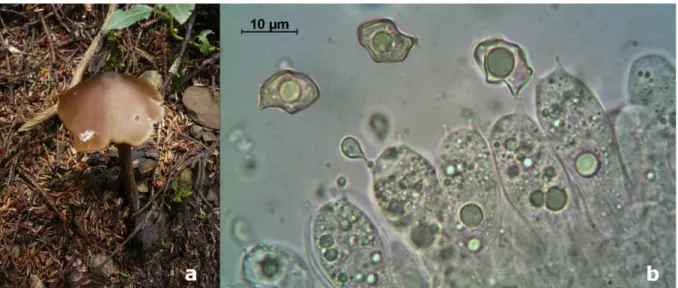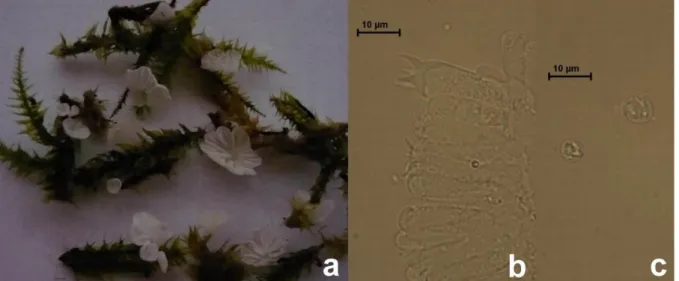www.biodicon.com Biological Diversity and Conservation
ISSN 1308-8084 Online; ISSN 1308-5301 Print 6/3 (2013) 150-152
Research article/Araştırma makalesi Two new records for Turkish Agaricales
Abdullah KAYA *1, Ilgaz AKATA 2, Yasin UZUN 3
1Karamanoğlu Mehmetbey University, Kâmil Özdağ Science Faculty, Department of Biology, 70100, Karaman, Turkey 2Ankara University, Faculty of Science, Department of Biology, 06100 Ankara, Turkey
Abstract
Entoloma asprellum (Fr.) Fayod (Entolomataceae) and Rimbachia bryophila (Pers.) Redhead (Tricholomataceae) are recorded for the first time from Turkey. Short descriptions of the taxa are given together with its photographs related to macro and micromorphologies
Key words: New records, Entoloma, Rimbchia, Turkey
--- ---
Agaraicales’ ten Türkiye için iki yeni kayıt Özet
Entoloma asprellum (Fr.) Fayod (Entolomataceae) and Rimbachia bryophila (Pers.) Redhead (Tricholomataceae) Türkiye’den ilk kez kaydedilmiştir. Makro ve mikro morfolojilerine ilişkin fotoğrafları ile birlikte türlerin kısa betimlemeleri verilmiştir
Anahtar kelimeler: Yeni kayıtlar, Entoloma, Rimbchia, Türkiye 1. Introduction
Entoloma (Fr.) P. Kumm is a large genus of the family Entolomataceae with about 1000 taxa (Kirk et al., 2008). Although some members of the genus form mycorrhizal relationships, most are sabrobic. Entoloma species are widespeared and found in a wide variety of habitats such as woodlands, grasslands moors, peat-bogs and arctic or alpine conditions. They may form clitocyboid, collybioid, omphalinoid, mycenoid, pleuroid or tricholomaoid basidiocarps, free to adnate, adnate-decurrent or decurrent lamellae, 2-4 spored basidia and angular spores (Hansen and Knudsen 1992; Bas et al., 1988).
Rimbachia Pat. is a genus of the family Tricholomataceae and represents eleven confirmed taxa with a widespread distribution in tropical regions (Kirk et al., 2008). The members of the genus are characterized by a sessile or short stiped, thin and membranous, white, pleurotoid, cyphelloid, flabelliform or cupulate basidiocarp, smooth, rugose or venose hymenophore, smooth, hyaline, thin walled, inamyloid, subglobose to ellipsoid spores with very prominent hilar appendix (Hansen and Knudsen 1992; Bas et al., 1995).
According to present literature on Turkish macrofungi (Solak et al., 2007; Sesli and Denchev, 2008, Akata et al., 2009; Akata 2012; Kaya et al., 2012; Sesli and Helfer 2013; Akata and Kaya, 2013; Atila and Kaya, 2013), Entoloma asprellum and Rimbachia bryophila have not previously been reported from Turkey.
The study aims to make a contribution to the macrofungi of Turkey by adding new records. 2. Materials and methods
Fruit bodies were collected from Zigana Mountain (Gümüşhane) and Uzungöl Nature Park (Trabzon) in 2011. During field studies, necessary morphological and ecological properties of the samples were noted and they were photographed in their natural habitats. Thereafter they were taken to the laboratory for necessary macroscopic and microscopic investigations. Identification was performed with the help of literature Breitenbach and Kränzlin (1995),
* Corresponding author / Haberleşmeden sorumlu yazar: Tel.: +903122126720/1066; Fax.: +903122126720/1066; E-mail: fungus@hotmail.com.tr © 2008 All rights reserved / Tüm hakları saklıdır BioDiCon. 348-0813
Abdullah KAYA et al., Two new records for Turkish Agaricales
Biological Diversity and Conservation – 6 / 3 (2013)
151
Bas et al. (1988; 1995) and Hansen and Knudsen (1992). The identified specimens are kept at Karamanoğlu Mehmetbey University, Kamil Özdağ Science Faculty, Department of Biology, Karaman, Turkey.
3. Results
The systematics of the taxa is in accordance with Kirk et al. (2008). Short descriptions and ecologies of newly recorded taxa are given together with their localities, collection dates and photographs related to their macro and micromorpholgies.
Agaricales Underw.
Entolomataceae Kotl. & Pouzar
Entoloma asprellum (Fr.) Fayod (1889) (Figure 1)
Syn.:Agaricus asprellus Fr. (1821), Leptonia asprella (Fr.) P. Kumm. (1871), Rhodophyllus asprellus (Fr.) Quél. (1886), Rhodophyllus asprellus (Fr.) Quél., (1886) var. asprellus, Rhodophyllus asprellus var. gracilis Romagn. (1956).
Macroscopic and microscopic features:
Pileus 15-25 mm across, conical to convex when young, then expanding to plano-convex, with slightly depressed umbonate centre, weakly hygrophanous, surface dull, radially fibrillose to deeply striate up to half the radius, chesnut brown when moist, light gray brown when dry, paler at margin, dark brown to blackish in the centre, margin densely radially fibrillose to squamulose (Figure 1a). Flesh gray-brown, thin in the centre, smell slightly farinaceus, taste slightly rancid. Lamellae grey at first, then dingy pink or pinkish, crowded, narrowly adnate, edge smooth. Stipe 40-50 × 2-3 mm, cylindrical, surface smooth, gray blue, base white tomentose (Figure 1a). Basidia 35-40 × 10 -13 µm, clavate, 4 spored (Figure 1b). Cystidia absent. Basidiospores 9-13 × 6-9 µm, 5-8 angled (Figure 1b), brown pink.
Ecology: Autumn, usually gregarious, rarely solitary, in moist grasslands, subalpine meadows among grasses, and herbs on soil or plant debris, preferably basic or neutral soil, primarily at montane to subalpine elevations, widespread (Breitenbach and Kränzlin, 1995).
Specimen examined: TURKEY—Trabzon: Uzungöl, near spruce (Picea orientalis L.), 40°37'N-40°17'E, 1520 m, 28.08.2011, Akata 4111.
Figure 1. Entoloma asprellum, a. Basidiocarp, b. Basidia and basidiospores Tricholomataceae R. Heim
Rimbachia bryophila (Pers.) Redhead (1984) (Figure 2).
Syn.: Agaricus bryophilus Pers. (1796), Cantharellus bryophilus (Pers.) Fr. (1821), Dictyolus bryophilus (Pers.) Quél. (1886), Leptoglossum bryophilum (Pers.) Ricken (1915), Leptotus bryophilus (Pers.) P. Karst.(1879), Merulius bryophilus (Pers.) Pers. (1801), Mniopetalum bryophilum (Pers.) Donk (1962).
Macroscopic and microscopic features:
Pileus 4-5 mm broad, sessile or with a short, lateral stipe, cupulate, pleurotoid to flabelliform in age, hygrohanous, smooth, sometimes silky to glabrous, margin incurved at first, then decurved (Figure 2a). Hymenophore white, smooth with very shallow veins. Flesh very thin and white. Basidia 20-25 × 7-8 µm, 4 spored (Figure 2b). Cystidia not seen. Basidiospores 6-8 × 5-7 µm, subglobose to dacryoid, hyaline, inamyloid, smooth with very prominent apiculus (Figure 2c).
Ecology: Parasitic on mosses in shady forests (Hansen and Knudsen 1992; Bas et al., 1995).
Specimen examined: TURKEY— Gümüşhane: Zigana mountain, on moss, 40°42'N- 39°27'E, 1400 m, 04.09.2011, Akata and Uzun 1019.
Abdullah KAYA et al., Two new records for Turkish Agaricales 152 Biological Diversity and Conservation – 6 / 3 (2013)
Figure 2. Rimbachia bryophila, a. Basidiocarps, b. Basidia, c. Basidiospores 4. Discussion
Though many Entoloma species seems to be similar to each other, they have so many characteristics to be differentiated from each other. Likewise, Entoloma asprellum is rather similar to Entoloma fulvoviolaceum Noordel. & Vauras by its macromorphology but it differs from the latter species by the less pronounced squamulose pileus and absence of cystidia.
Rimbachia bryophila could also be confused with Rimbachia arachnoidea (Peck) Redhead due to their morphology and ecology. Both species are parasitic on mosses. Rimbachia bryophila differs from the latter with its venose hymenophore.
According to the current checklists (Solak et al., 2007; Sesli and Denchev, 2008) and recent contributons (Akata et al., 2009; Akata 2012; Kaya et al., 2012; Sesli and Helfer 2013; Akata and Kaya, 2013; Atila and Kaya, 2013), 41 members of the genus Entoloma (Fr.) P. Kumm. currently exist in Turkey, while any member of Rimbachia Pat. have so far been given from Turkey. With this study, Entoloma asprellum is presented as new record as the 42nd member of Turkish Entoloma, and a contribution was also made with the introduction of the genus Rimbachia to the tricholomataceaous macrofungi of Turkey.
Acknowledgements
We would like to thank to Karamanoğlu Mehmetbey University Research Fund (Project No: 08-M-13) for its financial support.
References
Akata, I. 2012. Strobilomyces strobilaceus (Scop.) Berk. (Boletaceae Chevall.), a new genus record for Turkish Mycobiota. Biological Diversity and Conservation 5 /1: 75-77.
Akata, I., Doğan, H.H., Çetin, B., Işıloğlu, M. 2009. Onnia tomentosa (Fr.) P. Karst, a new genus record for Turkey. Biological Diversity and Conservation. 2/1: 78-81.
Akata, I., Kaya, A. 2013. Three pyronemataceous macrofungi genera new to Turkish Mycota. Turkish Journal of Botany 37: 977-980.
Atila, O.Y., Kaya, A. 2013. Macromycetes of Sarız (Kayseri) district. Biological Diversity and Conservation 6: 6/2: 50-54.
Bas, C., Kyper, T.W., Noordeloos, M.E. & Vellinga, E.C. 1995. Flora Agaricina Neerlandica—Critical monographs on the families of agarics and boleti occuring in the Netherlands. Volume 3. Tricholomataceae. A. A. Balkema: Rotterdam, Netherlands. Bas, C., Kyper, Th. W., Noordeloos, M. E. and Vellinga, E. C. 1988. Flora Agaricina Neerlandica -Critical monographs on the
families of agarics and boleti occuring in the Netherlands. Volume 1. Entolomataceae. A.A. Balkema, 182 p., Rotterdam, Netherlands.
Breitenbach, J. and Kränzlin, F. 1995. Fungi of Switzerland. Vol: 4, Agarics 2. Part, Verlag Mykologia CH-6000 Luzern 9, 368 p., Switzerland.
Hansen, L. and Knudsen, H. 1992. Nordic Macromycetes. Volume 2. Polyporales, Boletales, Agaricales, Russulales. Nordsvamp, 474 p, Copenhagen, Denmark.
Kaya, A., Demirel, K., Uzun, Y. 2012. Macrofungal diversity of Araban (Gaziantep/Turkey) district. Biological Diversity and Conservation 5 (3): 162-166.
Kirk, P.F., Cannon, P.F., Minter, D.W., Stalpers, J.A. 2008. Dictionary of the fungi, 10th ed. CAB International, 771 p.,Wallingford, UK.
Sesli, E., Denchev, C.M. 2008. Checklists of the myxomycetes, larger ascomycetes, and larger basidiomycetes in Turkey. – Mycotaxon 106: 65–67. + [complete version, 1–145, new version uploaded in January 2013].
Sesli, E., Helfer, S. 2013. New fungal records for the Turkish Mycota from Trabzon. Turkish Journal of Botany. 37: 414-417. Solak, M.H., Işıloğlu, M., Kalmış, E., Allı, H. 2007. Macrofungi of Turkey, Checklist, Volume- I. Üniversiteliler Ofset, Bornova,
İzmir.

